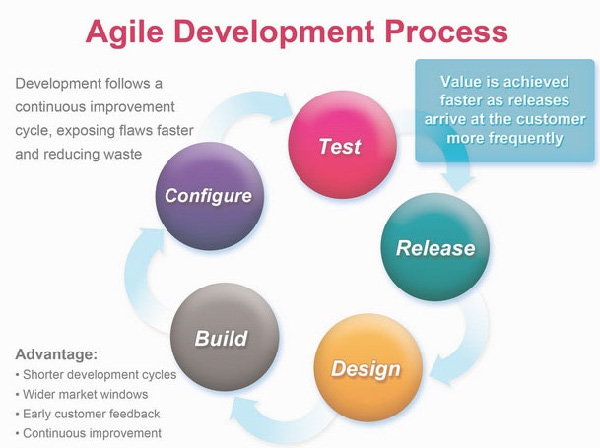Which of the following software development methods is based on iterative and incremental development, where requirements and solutions evolve through collaboration between self-organizing, cross-functional teams?
A. Agile Development
B. Software prototyping
C. Rapid application development
D. Component based development
A. Agile Development
B. Software prototyping
C. Rapid application development
D. Component based development
Correct Answer: A
Explanation:
Explanation:
For your exam you should know below information about agile development:
Agile software development is a group of software development methods based on iterative and incremental development, where requirements and solutions evolve through collaboration between self-organizing, cross-functional teams. It promotes adaptive planning, evolutionary development and delivery, a time-boxed iterative approach, and encourages rapid and flexible response to change. It is a conceptual framework that promotes foreseen tight iterations throughout the development cycle.
Agile Development

The Agile Manifesto introduced the term in 2001. Since then, the Agile Movement, with all its values, principles, methods, practices, tools, champions and practitioners, philosophies and cultures, has significantly changed the landscape of the modern software engineering and commercial software development in the Internet era.
Agile principles
The Agile Manifesto is based on twelve principles:
Customer satisfaction by rapid delivery of useful software
Welcome changing requirements, even late in development
Working software is delivered frequently (weeks rather than months)
Close, daily cooperation between business people and developers
Projects are built around motivated individuals, who should be trusted
Face-to-face conversation is the best form of communication (co-location)
Working software is the principal measure of progress
Sustainable development, able to maintain a constant pace
Continuous attention to technical excellence and good design
Simplicity—the art of maximizing the amount of work not done—is essential
Self-organizing teams
Regular adaptation to changing circumstances
What is Scrum?
Scrum is the most popular way of introducing Agility due to its simplicity and flexibility. Because of this popularity, many organizations claim to be “doing Scrum” but aren’t doing anything close to Scrum’s actual definition. Scrum emphasizes empirical feedback, team self-management, and striving to build properly tested product increments within short iterations. Doing Scrum as it’s actually defined usually comes into conflict with existing habits at established non-Agile organizations.
The following were incorrect answers:
Software prototyping- Software prototyping, refers to the activity of creating prototypes of software applications, i.e., incomplete versions of the software program being developed. It is an activity that can occur in software development and is comparable to prototyping as known from other fields, such as mechanical engineering or manufacturing.
Rapid application development (RAD) is a software development methodology that uses minimal planning in favor of rapid prototyping. The “planning” of software developed using RAD is interleaved with writing the software itself. The lack of extensive perplanning generally allows software to be written much faster, and makes it easier to change requirements.
Component Based Development – It is a reuse-based approach to defining, implementing and composing loosely coupled independent components into systems. This practice aims to bring about an equally wide-ranging degree of benefits in both the short-term and the long-term for the software itself and for organizations that sponsor such software.
Reference:
CISA review manual 2014 Page number 194
For your exam you should know below information about agile development:
Agile software development is a group of software development methods based on iterative and incremental development, where requirements and solutions evolve through collaboration between self-organizing, cross-functional teams. It promotes adaptive planning, evolutionary development and delivery, a time-boxed iterative approach, and encourages rapid and flexible response to change. It is a conceptual framework that promotes foreseen tight iterations throughout the development cycle.
Agile Development

The Agile Manifesto introduced the term in 2001. Since then, the Agile Movement, with all its values, principles, methods, practices, tools, champions and practitioners, philosophies and cultures, has significantly changed the landscape of the modern software engineering and commercial software development in the Internet era.
Agile principles
The Agile Manifesto is based on twelve principles:
Customer satisfaction by rapid delivery of useful software
Welcome changing requirements, even late in development
Working software is delivered frequently (weeks rather than months)
Close, daily cooperation between business people and developers
Projects are built around motivated individuals, who should be trusted
Face-to-face conversation is the best form of communication (co-location)
Working software is the principal measure of progress
Sustainable development, able to maintain a constant pace
Continuous attention to technical excellence and good design
Simplicity—the art of maximizing the amount of work not done—is essential
Self-organizing teams
Regular adaptation to changing circumstances
What is Scrum?
Scrum is the most popular way of introducing Agility due to its simplicity and flexibility. Because of this popularity, many organizations claim to be “doing Scrum” but aren’t doing anything close to Scrum’s actual definition. Scrum emphasizes empirical feedback, team self-management, and striving to build properly tested product increments within short iterations. Doing Scrum as it’s actually defined usually comes into conflict with existing habits at established non-Agile organizations.
The following were incorrect answers:
Software prototyping- Software prototyping, refers to the activity of creating prototypes of software applications, i.e., incomplete versions of the software program being developed. It is an activity that can occur in software development and is comparable to prototyping as known from other fields, such as mechanical engineering or manufacturing.
Rapid application development (RAD) is a software development methodology that uses minimal planning in favor of rapid prototyping. The “planning” of software developed using RAD is interleaved with writing the software itself. The lack of extensive perplanning generally allows software to be written much faster, and makes it easier to change requirements.
Component Based Development – It is a reuse-based approach to defining, implementing and composing loosely coupled independent components into systems. This practice aims to bring about an equally wide-ranging degree of benefits in both the short-term and the long-term for the software itself and for organizations that sponsor such software.
Reference:
CISA review manual 2014 Page number 194